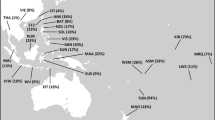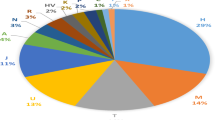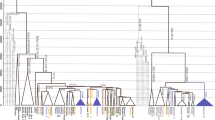Abstract
Y-chromosome Haplogroup O is the dominant lineage of East Asians, comprising more than a quarter of all males on the world; however, its internal phylogeny remains insufficiently investigated. In this study, we determined the phylogenetic position of recently defined markers (L127, KL1, KL2, P164, and PK4) in the background of Haplogroup O. In the revised tree, subgroup O3a-M324 is divided into two main subclades, O3a1-L127 and O3a2-P201, covering about 20 and 35% of Han Chinese people, respectively. The marker P164 is corrected from a downstream site of M7 to upstream of M134 and parallel to M7 and M159. The marker PK4 is also relocated from downstream of M88 to upstream of M95, separating the former O2* into two parts. This revision evidently improved the resolving power of Y-chromosome phylogeny in East Asia.
Similar content being viewed by others
Log in or create a free account to read this content
Gain free access to this article, as well as selected content from this journal and more on nature.com
or
References
Jin L, Su B : Natives or immigrants: modern human origin in East Asia. Nat Rev Genet 2000; 1: 126–133.
Jobling MA, Tyler-Smith C : The human Y chromosome: an evolutionary marker comes of age. Nat Rev Genet 2003; 4: 598–612.
Sykes B, Irven C : Surnames and the Y chromosome. Am J Hum Genet 2000; 66: 1417–1419.
Karafet TM, Hallmark B, Cox MP et al: Major east-west division underlies Y-chromosome stratification across Indonesia. Mol BiolEvol 2010; 27: 1833–1844.
Li H, Wen B, Chen SJ et al: Paternal genetic affinity between western Austronesians and Daic populations. BMC Evol Biol 2008; 8: 146.
Su B, Xiao JH, Underhill P et al: Y-chromosome evidence for a northward migration of modern humans into Eastern Asia during the last Ice Age. Am J Hum Genet 1999; 65: 1718–1724.
Hammer MF, Karafet TM, Park H et al: Dual origins of the Japanese: common ground for hunter-gatherer and farmer Y chromosomes. J Hum Genet 2006; 51: 47–58.
Nonaka I, Minaguchi K, Takezaki N : Y-chromosomal binary haplogroups in the Japanese population and their relationship to 16 Y-STR polymorphisms. Ann Hum Genet 2007; 71: 480–495.
Xue YL, Zejal T, Bao WD et al: Male demography in East Asia: a north-south contrast in human population expansion times. Genetics 2006; 172: 2431–2439.
Karafet TM, Mendez FL, Meilerman MB, Underhill PA, Zegura SL, Hammer MF : New binary polymorphisms reshape and increase resolution of the human Y chromosomal haplogroup tree. Genome Res 2008; 18: 830–838.
Deng W, Shi BC, He XL et al: Evolution and migration history of the Chinese population inferred from Chinese Y-chromosome evidence. J Hum Genet 2004; 49: 339–348.
Shi H, Dong YL, Wen B et al: Y-chromosome evidence of southern origin of the East Asian-specific haplogroup O3-M122. Am J Hum Genet 2005; 77: 408–419.
The International HapMap Consortium: A haplotype map of the human genome. Nature 2005; 437: 1299–1320.
Firasat S, Khaliq S, Mohyuddin A et al: Y-chromosomal evidence for a limited Greek contribution to the Pathan population of Pakistan. Eur J Hum Genet 2007; 15: 121–126.
Inagaki S, Yamamoto Y, Doi Y et al: Typing of Y chromosome single nucleotide polymorphisms in a Japanese population by a multiplexed single nucleotide primer extension reaction. Leg Med (Tokyo) 2002; 4: 202–206.
The Y-Chromosome Consortium: A nomenclature system for the tree of human Y-chromosomal binary haplogroups. Genome Res 2002; 12: 339–348.
Su B, Deka R, Xiao C et al: The origin and genetic affinity of Sino-Tibetan speaking populations. Am J Human Genetics 1999; 65: 2260.
Fornarino S, Pala M, Battaglia V et al: Mitochondrial and Y-chromosome diversity of the Tharus (Nepal): a reservoir of genetic variation. BMC Evol Biol 2009; 9: 154.
Acknowledgements
This research was supported by grants from the National Outstanding Youth Science Foundation of China (30625016) and National Science Foundation of China (30890034). Genographic Consortium members are the following: Theodore G. Schurr (University of Pennsylvania, Philadelphia, PA, USA), Fabricio R.Santos (Universidade Federal de Minas Gerais, Belo Horizonte, Brazil), Lluis Quintana-Murci (Institut Pasteur, Paris, France), Jaume Bertranpetit, David Comas (Universitat Pompeu Fabra, Barcelona, Spain), Chris Tyler-Smith (The Wellcome Trust Sanger Institute, Hinxton, UK), Pierre A. Zalloua (Lebanese American University, Chouran, Beirut, Lebanon), Elena Balanovska, Oleg Balanovsky (Russian Academy of Medical Sciences, Moscow, Russia), R. John Mitchell (La Trobe University, Melbourne, Australia), Li Jin (Fudan University, Shanghai, China), Himla Soodyall (National Health Laboratory Service, Johannesburg, South Africa), Ramasamy Pitchappan (Madurai Kamaraj University, Madurai, India), Alan Cooper (University of Adelaide, Adelaide, Australia), Lisa Matisoo-Smith (University of Auckland, Auckland, New Zealand), Ajay K. Royyuru, Daniel E. Platt, Laxmi Parida (IBM, Yorktown Heights, New York, NY, USA), Jason Blue-Smith, David F. Soria Hernanz, and R. Spencer Wells (National Geographic Society, Washington, D.C., USA).
Author information
Authors and Affiliations
Consortia
Corresponding authors
Ethics declarations
Competing interests
The authors declare no conflict of interest.
Rights and permissions
About this article
Cite this article
Yan, S., Wang, CC., Li, H. et al. An updated tree of Y-chromosome Haplogroup O and revised phylogenetic positions of mutations P164 and PK4. Eur J Hum Genet 19, 1013–1015 (2011). https://doi.org/10.1038/ejhg.2011.64
Received:
Revised:
Accepted:
Published:
Issue date:
DOI: https://doi.org/10.1038/ejhg.2011.64
Keywords
This article is cited by
-
Contrasting maternal and paternal genetic histories among five ethnic groups from Khyber Pakhtunkhwa, Pakistan
Scientific Reports (2022)
-
Paternal genetic history of the Yong population in northern Thailand revealed by Y-chromosomal haplotypes and haplogroups
Molecular Genetics and Genomics (2020)
-
Genetic diversity of the Thao people of Taiwan using Y-chromosome, mitochondrial DNA and HLA gene systems
BMC Evolutionary Biology (2019)
-
Molecular genealogy of Tusi Lu’s family reveals their paternal relationship with Jochi, Genghis Khan’s eldest son
Journal of Human Genetics (2019)
-
The Marquesans at the fringes of the Austronesian expansion
European Journal of Human Genetics (2019)



